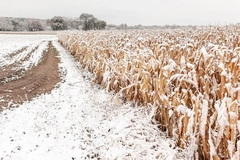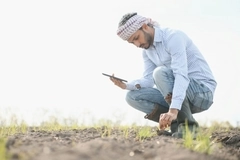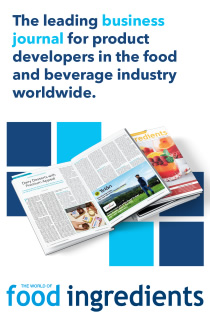
- Industry news
Industry news
- Category news
Category news
- Reports
- Key trends
- Multimedia
- Journal
- Events
- Suppliers
- Home
- Industry news
Industry news
- Category news
Category news
- Reports
- Key trends
- Multimedia
- Events
- Suppliers
US scientists develop “eco-friendly” paper-based sensors for enhanced agricultural efficiency
Climate change is driving the agricultural industry to find better ways to monitor and improve greenhouse crop growth and yield. But keeping harvested food fresh during storage remains a major challenge for farmers. To overcome this, Auburn University researchers in the US have developed eco-friendly paper-based sensors which can monitor temperature and humidity for crop production and preservation.
The team picked paper as a suitable alternative to the traditional plastic materials used in manufacturing sensors since paper’s cellulose fibers provide a porous surface, while also being biodegradable and abundant.
The research team says the devices have substantial implications for use in smart agricultural applications, food supply, storage and preservation.
“Agriculture continually faces challenges from climate change, harsh environments and infertile lands that affect food productivity,” Dr. Masoud Mahjouri-Samani, Godbold associate professor, Electrical and Computer Engineering at the university, tells Food Ingredients First. He led the study with his Ph.D student Suman Jaiswal.
“This research develops eco-friendly and cost-effective paper-based sensors to monitor temperature and humidity, which are critical abiotic factors for plant growth. This supports incorporating smart sensor technologies into agriculture, leading to improving food production and minimizing environmental impact.”
 The sensors measure how the paper absorbs humidity and the response of the silver electrodes to temperature change (Image credit: Auburn University).Balancing functionality and sustainability
The sensors measure how the paper absorbs humidity and the response of the silver electrodes to temperature change (Image credit: Auburn University).Balancing functionality and sustainability
The team developed the sensors by printing silver lines on four types of papers of different thicknesses and solubility through dry additive nanomanufacturing. These sensors measure how the paper absorbs humidity and the response of the silver electrodes to temperature changes, notes the study, published in the Journal of Laser Applications.
“Paper is an ideal substrate material for these sensors as they are abundantly available, cost-effective and lightweight. Unlike traditional materials like polyethylene terephthalate (PET) and polyamide, the paper offers significant advantages like a mature manufacturing process, mechanical flexibility, environmental friendliness and non-toxicity,” explains Dr. Mahjouri-Samani.
“The biodegradability of the paper enables sensors printed on paper to be easily recycled or disposed of, as they can be broken down more easily than nonbiodegradable substrates. By integrating advanced techniques like dry additive nanomanufacturing with biodegradable substrates, this research combines functionality with environmental responsibility, addressing the growing concern of e-waste.”
Global e-waste generation is rising “five times” faster than documented e-waste recycling, the UN’s fourth Global E-waste Monitor revealed recently. Nearly 62 million metric tons of e-waste was produced in 2022, up 82% from 2010 and is predicted to rise another 32% to 82 million metric tons in 2030.
The paper-based sensors address these concerns as they can be intended for one or two time applications and disposed of after use. “Their affordability and biodegradability make them practical for widespread, disposable use,” he adds.
 The scientists used dry printing technology to print eco-friendly humidity (b) and temperature (c) sensors. The sensors’ response to humidity (d) and temperature (e).
The scientists used dry printing technology to print eco-friendly humidity (b) and temperature (c) sensors. The sensors’ response to humidity (d) and temperature (e).
Advancing real-time crop monitoring
The sensors are relevant for smart agricultural applications, including real-time monitoring of environmental conditions in greenhouses and open farms, as well as in food supply, storage and preservation systems, Dr. Mahjouri-Samani continues.
“The humidity and temperature sensors demonstrated consistent sensitivity across varying environmental conditions, proving their reliability.”
The devices are sensitive to changes in temperature and humidity levels and successfully detected changes in relative humidity levels from 20% to 90% and temperature variations from 25℃ to 50℃, the study highlights.
Dr. Mahjouri-Samani further points to some technical challenges faced while developing the sensors, such as ensuring compatibility between the printing method and biodegradable substrates “without diminishing their eco-friendliness.”
“Most traditional printing techniques are ink-based and incompatible with biodegradable paper. Our laboratory developed a dry additive nanomanufacturing process that avoided the use of liquid inks while achieving high-resolution printed patterns and reliable performance.”
 Smart agricultural applications of the eco-friendly sensors can be used in greenhouses and open farms.Digital transformation with AI and IoT
Smart agricultural applications of the eco-friendly sensors can be used in greenhouses and open farms.Digital transformation with AI and IoT
In the next decade, Dr. Mahjouri-Samani expects smart agricultural technologies to “evolve significantly with the integration of the Internet of Things (IoT) and AI.”
“The development of eco-friendly, cost-effective, disposable sensors will play a crucial role in this transformation. These sensors, like the ones developed in this research, provide real-time monitoring of critical environmental parameters like temperature, humidity and other environmental factors, enabling precise control over growing conditions in greenhouses and farms.”
“Their biodegradable design addresses sustainability concerns, while affordability addresses widespread use. As agriculture embraces digital transformation, these sensors will become integral in creating smarter, more sustainable food production systems.”
Next steps
The team’s next steps focus on improving the durability and stability of the paper-based sensors under extreme environmental conditions, Dr. Mahjouri-Samani tells us.
They also aim to optimize the dry additive nanomanufacturing process to “enhance adhesion, conductivity and biodegradability.”
“Integrating these sensors into IoT systems for real-time data collection in the agricultural field, exploring alternative biodegradable materials and developing multi-functional sensors for parameters like soil moisture and light intensity are promising directions,” he concludes.
Other recent global efforts at crop monitoring include European traders ramping up crop monitoring to manage mycotoxins for food and feed safety and Canadian research exploring cold plasma techniques to reduce contamination in wheat and barley.


















